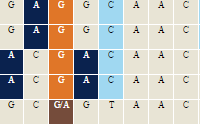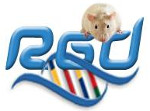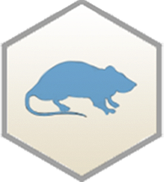| 1. |
Hemodynamic parameters during normal and hypertensive pregnancy in rats: evaluation of renal salt and water transporters. |
Abreu N, etal., Hypertens Pregnancy. 2008;27(1):49-63.
|
| 2. |
Aquaporin-2 and urea transporter-A1 are up-regulated in rats with type I diabetes mellitus. |
Bardoux P, etal., Diabetologia. 2001 May;44(5):637-45.
|
| 3. |
Large scale protein identification in intracellular aquaporin-2 vesicles from renal inner medullary collecting duct. |
Barile M, etal., Mol Cell Proteomics. 2005 Aug;4(8):1095-106. Epub 2005 May 18.
|
| 4. |
Regulation of the basolateral chloride/base exchangers AE1 and SLC26A7 in the kidney collecting duct in potassium depletion. |
Barone S, etal., Nephrol Dial Transplant. 2007 Dec;22(12):3462-70. Epub 2007 Sep 5.
|
| 5. |
Physiology and pathophysiology of the vasopressin-regulated renal water reabsorption. |
Boone M and Deen PM, Pflugers Arch. 2008 Sep;456(6):1005-24. Epub 2008 Apr 23.
|
| 6. |
Characterization of V71M mutation in the aquaporin-2 gene causing nephrogenic diabetes insipidus. |
Bougacha-Elleuch N, etal., J Genet. 2008 Dec;87(3):279-82.
|
| 7. |
Urinary concentrating defect in hypothyroid rats: role of sodium, potassium, 2-chloride co-transporter, and aquaporins. |
Cadnapaphornchai MA, etal., J Am Soc Nephrol 2003 Mar;14(3):566-74.
|
| 8. |
Novel mutations underlying nephrogenic diabetes insipidus in Arab families. |
Carroll P, etal., Genet Med. 2006 Jul;8(7):443-7.
|
| 9. |
Modulation of aquaporin-2/vasopressin2 receptor kidney expression and tubular injury after endotoxin (lipopolysaccharide) challenge. |
Chagnon F, etal., Crit Care Med. 2008 Nov;36(11):3054-61.
|
| 10. |
Aquaporin-2 downregulation in kidney medulla of aging rats is posttranscriptional and is abolished by water deprivation. |
Combet S, etal., Am J Physiol Renal Physiol. 2008 Jun;294(6):F1408-14. Epub 2008 Mar 26.
|
| 11. |
Long-term aldosterone treatment induces decreased apical but increased basolateral expression of AQP2 in CCD of rat kidney. |
de Seigneux S, etal., Am J Physiol Renal Physiol. 2007 Jul;293(1):F87-99. Epub 2007 Mar 20.
|
| 12. |
Role of AQP2 during apoptosis in cortical collecting duct cells. |
Flamenco P, etal., Biol Cell. 2009 Apr;101(4):237-50.
|
| 13. |
Cloning and expression of apical membrane water channel of rat kidney collecting tubule. |
Fushimi K, etal., Nature 1993 Feb 11;361(6412):549-52.
|
| 14. |
Osmolarity and intracellular calcium regulate aquaporin2 expression through TonEBP in nucleus pulposus cells of the intervertebral disc. |
Gajghate S, etal., J Bone Miner Res. 2009 Jun;24(6):992-1001.
|
| 15. |
Role of AQP2 in activation of calcium entry by hypotonicity: implications in cell volume regulation. |
Galizia L, etal., Am J Physiol Renal Physiol. 2008 Mar;294(3):F582-90. Epub 2007 Dec 19.
|
| 16. |
Aquaporin-2, a regulated water channel, is expressed in apical membranes of rat distal colon epithelium. |
Gallardo P, etal., Am J Physiol Gastrointest Liver Physiol 2001 Sep;281(3):G856-63.
|
| 17. |
Phylogenetic-based propagation of functional annotations within the Gene Ontology consortium. |
Gaudet P, etal., Brief Bioinform. 2011 Sep;12(5):449-62. doi: 10.1093/bib/bbr042. Epub 2011 Aug 27.
|
| 18. |
Rat ISS GO annotations from GOA human gene data--August 2006 |
GOA data from the GO Consortium
|
| 19. |
Characterization of D150E and G196D aquaporin-2 mutations responsible for nephrogenic diabetes insipidus: importance of a mild phenotype. |
Guyon C, etal., Am J Physiol Renal Physiol. 2009 Aug;297(2):F489-98. Epub 2009 May 20.
|
| 20. |
Long term regulation of aquaporin-2 expression in vasopressin-responsive renal collecting duct principal cells. |
Hasler U, etal., J Biol Chem 2002 Mar 22;277(12):10379-86. Epub 2002 Jan 8.
|
| 21. |
Identification of a novel A-kinase anchoring protein 18 isoform and evidence for its role in the vasopressin-induced aquaporin-2 shuttle in renal principal cells. |
Henn V, etal., J Biol Chem 2004 Jun 18;279(25):26654-65. Epub 2004 Mar 22.
|
| 22. |
Rapid isolation of tissue-specific genes from rat kidney. |
Hu E, etal., Exp Nephrol 2001 Mar-Apr;9(2):156-64.
|
| 23. |
Angiotensin II regulates V2 receptor and pAQP2 during ureteral obstruction. |
Jensen AM, etal., Am J Physiol Renal Physiol. 2009 Jan;296(1):F127-34. Epub 2008 Oct 29.
|
| 24. |
Repulsion between Lys258 and upstream arginines explains the missorting of the AQP2 mutant p.Glu258Lys in nephrogenic diabetes insipidus. |
Kamsteeg EJ, etal., Hum Mutat. 2009 Oct;30(10):1387-96.
|
| 25. |
Changes in renal medullary transport proteins during uncontrolled diabetes mellitus in rats. |
Kim D, etal., Am J Physiol Renal Physiol 2003 Aug;285(2):F303-9. Epub 2003 Apr 15.
|
| 26. |
Indomethacin enhances shuttling of aquaporin-2 despite decreased abundance in rat kidney. |
Kim SW, etal., J Am Soc Nephrol. 2004 Dec;15(12):2998-3005.
|
| 27. |
Urea transporter UT-A1 and aquaporin-2 proteins decrease in response to angiotensin II or norepinephrine-induced acute hypertension. |
Klein JD, etal., Am J Physiol Renal Physiol. 2006 Nov;291(5):F952-9. Epub 2006 Jun 20.
|
| 28. |
Urinary excretion of aquaporin-2 water channel in diabetic ketoacidosis. |
Kusaka I, etal., Nephron. 2002 May;91(1):167-9.
|
| 29. |
Aquaporins in the kidney. |
Kwon TH, etal., Handb Exp Pharmacol. 2009;(190):95-132. doi: 10.1007/978-3-540-79885-9_5.
|
| 30. |
Increased expression of renal aquaporin water channels in spontaneously hypertensive rats. |
Lee J, etal., Kidney Blood Press Res. 2006;29(1):18-23. Epub 2006 Mar 22.
|
| 31. |
Differential expression of aquaporins in the kidneys of streptozotocin-induced diabetic mice. |
Leung JC, etal., Nephrology (Carlton). 2005 Feb;10(1):63-72.
|
| 32. |
Downregulation of renal aquaporins in response to unilateral ureteral obstruction. |
Li C, etal., Am J Physiol Renal Physiol 2003 May;284(5):F1066-79.
|
| 33. |
Heat shock protein 70 interacts with aquaporin-2 and regulates its trafficking. |
Lu HA, etal., J Biol Chem. 2007 Sep 28;282(39):28721-32. Epub 2007 Jul 18.
|
| 34. |
Cell-biologic and functional analyses of five new Aquaporin-2 missense mutations that cause recessive nephrogenic diabetes insipidus. |
Marr N, etal., J Am Soc Nephrol. 2002 Sep;13(9):2267-77.
|
| 35. |
Congenital progressive hydronephrosis (cph) is caused by an S256L mutation in aquaporin-2 that affects its phosphorylation and apical membrane accumulation. |
McDill BW, etal., Proc Natl Acad Sci U S A. 2006 May 2;103(18):6952-7. Epub 2006 Apr 25.
|
| 36. |
Spatial organisation of AKAP18 and PDE4 isoforms in renal collecting duct principal cells. |
McSorley T, etal., Eur J Cell Biol. 2006 Jul;85(7):673-8. Epub 2006 Feb 28.
|
| 37. |
Rat ISS GO annotations from MGI mouse gene data--August 2006 |
MGD data from the GO Consortium
|
| 38. |
Serine 269 phosphorylated aquaporin-2 is targeted to the apical membrane of collecting duct principal cells. |
Moeller HB, etal., Kidney Int. 2009 Feb;75(3):295-303. Epub 2008 Oct 8.
|
| 39. |
Novel mutation of aquaporin-2 gene in a patient with congenital nephrogenic diabetes insipidus. |
Moon SS, etal., Endocr J. 2009;56(7):905-10. Epub 2009 May 20.
|
| 40. |
Importance of the mercury-sensitive cysteine on function and routing of AQP1 and AQP2 in oocytes. |
Mulders SM, etal., Am J Physiol. 1997 Sep;273(3 Pt 2):F451-6.
|
| 41. |
Decrease in urinary excretion of aquaporin-2 associated with impaired urinary concentrating ability in diabetic nephropathy. |
Nakamura T, etal., Nephron. 2002 Oct;92(2):445-8.
|
| 42. |
Electronic Transfer of LocusLink and RefSeq Data |
NCBI rat LocusLink and RefSeq merged data July 26, 2002
|
| 43. |
Compensatory increase in AQP2, p-AQP2, and AQP3 expression in rats with diabetes mellitus. |
Nejsum LN, etal., Am J Physiol Renal Physiol 2001 Apr;280(4):F715-26.
|
| 44. |
Functional requirement of aquaporin-5 in plasma membranes of sweat glands. |
Nejsum LN, etal., Proc Natl Acad Sci U S A 2002 Jan 8;99(1):511-516.
|
| 45. |
Proteomic analysis of lithium-induced nephrogenic diabetes insipidus: mechanisms for aquaporin 2 down-regulation and cellular proliferation. |
Nielsen J, etal., Proc Natl Acad Sci U S A. 2008 Mar 4;105(9):3634-9. Epub 2008 Feb 22.
|
| 46. |
Water channel aquaporin-2 directly binds to actin. |
Noda Y, etal., Biochem Biophys Res Commun 2004 Sep 24;322(3):740-5.
|
| 47. |
Identification of a multiprotein "motor" complex binding to water channel aquaporin-2. |
Noda Y, etal., Biochem Biophys Res Commun. 2005 May 20;330(4):1041-7.
|
| 48. |
Aquaporin-2 trafficking is regulated by PDZ-domain containing protein SPA-1. |
Noda Y, etal., FEBS Lett. 2004 Jun 18;568(1-3):139-45.
|
| 49. |
Reciprocal interaction with G-actin and tropomyosin is essential for aquaporin-2 trafficking. |
Noda Y, etal., J Cell Biol. 2008 Aug 11;182(3):587-601. Epub 2008 Aug 4.
|
| 50. |
AKAP220 colocalizes with AQP2 in the inner medullary collecting ducts. |
Okutsu R, etal., Kidney Int. 2008 Dec;74(11):1429-33. Epub 2008 Aug 13.
|
| 51. |
OMIM Disease Annotation Pipeline |
OMIM Disease Annotation Pipeline
|
| 52. |
KEGG Annotation Import Pipeline |
Pipeline to import KEGG annotations from KEGG into RGD
|
| 53. |
SMPDB Annotation Import Pipeline |
Pipeline to import SMPDB annotations from SMPDB into RGD
|
| 54. |
Vasopressin V(2)-receptor-dependent regulation of AQP2 expression in Brattleboro rats. |
Promeneur D, etal., Am J Physiol Renal Physiol. 2000 Aug;279(2):F370-82.
|
| 55. |
Cloning of rat and mouse aquaporin-2 gene promoters and identification of a negative cis-regulatory element. |
Rai T, etal., Am J Physiol 1997 Aug;273(2 Pt 2):F264-73.
|
| 56. |
GOA pipeline |
RGD automated data pipeline
|
| 57. |
ClinVar Automated Import and Annotation Pipeline |
RGD automated import pipeline for ClinVar variants, variant-to-disease annotations and gene-to-disease annotations
|
| 58. |
Data Import for Chemical-Gene Interactions |
RGD automated import pipeline for gene-chemical interactions
|
| 59. |
Aquaporin-2 transcript is differentially regulated by dietary salt in Sprague-Dawley and Dahl SS/Jr rats. |
Roxas B, etal., Biochem Biophys Res Commun 2002 Aug 23;296(3):755.
|
| 60. |
p.R254Q mutation in the aquaporin-2 water channel causing dominant nephrogenic diabetes insipidus is due to a lack of arginine vasopressin-induced phosphorylation. |
Savelkoul PJ, etal., Hum Mutat. 2009 Oct;30(10):E891-903.
|
| 61. |
Nephrogenic diabetes insipidus in mice caused by deleting COOH-terminal tail of aquaporin-2. |
Shi PP, etal., Am J Physiol Renal Physiol. 2007 May;292(5):F1334-44. Epub 2007 Jan 16.
|
| 62. |
Pathogenesis and treatment of autosomal-dominant nephrogenic diabetes insipidus caused by an aquaporin 2 mutation. |
Sohara E, etal., Proc Natl Acad Sci U S A. 2006 Sep 19;103(38):14217-22. Epub 2006 Sep 12.
|
| 63. |
Expression, localization, and regulation of aquaporin-1 to -3 in rat urothelia. |
Spector DA, etal., Am J Physiol Renal Physiol 2002 Jun;282(6):F1034-42.
|
| 64. |
Novel treatment for lithium-induced nephrogenic diabetes insipidus rat model using the Sendai-virus vector carrying aquaporin 2 gene. |
Suga H, etal., Endocrinology. 2008 Nov;149(11):5803-10. Epub 2008 Jul 24.
|
| 65. |
Compound heterozygous mutation of aquaporin 2 gene in woman patient with congenital nephrogenic diabetes insipidus. |
Tsutsumi Z, etal., Intern Med. 2009;48(6):437-40. Epub 2009 Mar 16.
|
| 66. |
Expression of aquaporin water channels in rat taste buds. |
Watson KJ, etal., Chem Senses. 2007 Jun;32(5):411-21. Epub 2007 Mar 5.
|
| 67. |
Vasopressin-independent regulation of collecting duct aquaporin-2 in food deprivation. |
Wilke C, etal., Kidney Int. 2005 Jan;67(1):201-16.
|
| 68. |
Mouse model of inducible nephrogenic diabetes insipidus produced by floxed aquaporin-2 gene deletion. |
Yang B, etal., Am J Physiol Renal Physiol. 2006 Aug;291(2):F465-72. Epub 2006 Jan 24.
|
| 69. |
Neonatal mortality in an aquaporin-2 knock-in mouse model of recessive nephrogenic diabetes insipidus. |
Yang B, etal., J Biol Chem 2001 Jan 26;276(4):2775-9. Epub 2000 Oct 16.
|
| 70. |
Aquaporin 2 expression increased by glucagon in normal rat inner medullary collecting ducts. |
Yano Y, etal., Am J Physiol Renal Physiol. 2009 Jan;296(1):F54-9. Epub 2008 Oct 1.
|
| 71. |
Potential role of purinergic signaling in lithium-induced nephrogenic diabetes insipidus. |
Zhang Y, etal., Am J Physiol Renal Physiol. 2009 May;296(5):F1194-201. Epub 2009 Feb 25.
|
| 72. |
Identification of phosphorylation-dependent binding partners of aquaporin-2 using protein mass spectrometry. |
Zwang NA, etal., J Proteome Res. 2009 Mar;8(3):1540-54.
|





































